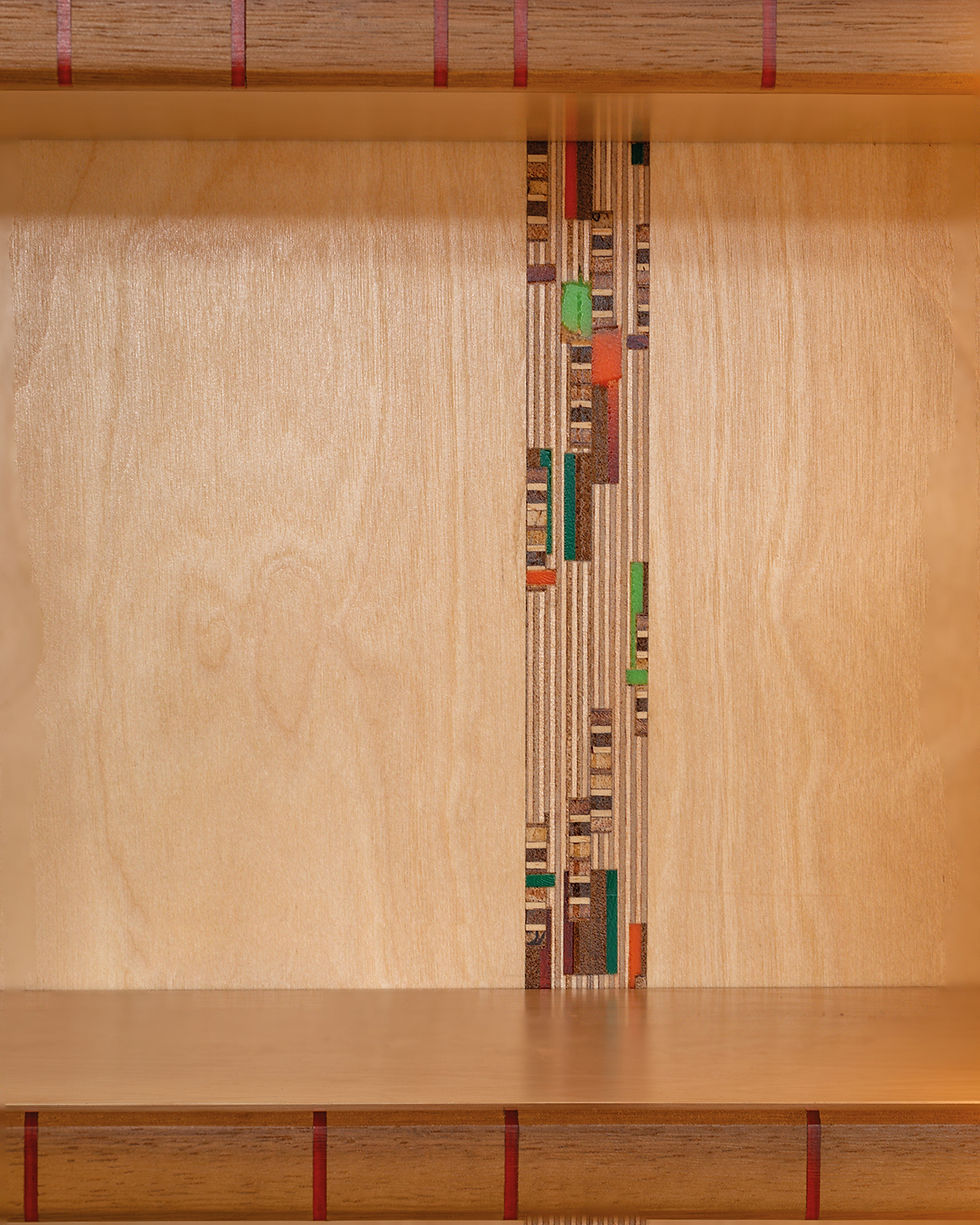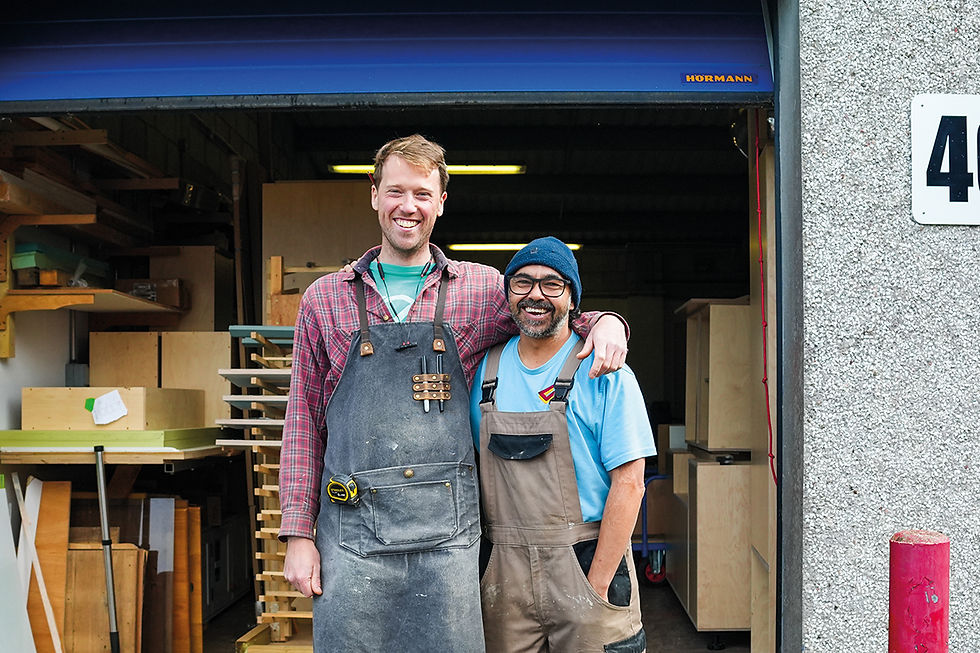Repurposed for a Purpose
- Jamie Crocker

- Jul 3
- 5 min read
Words by Jamie Crocker
Paired craftsmen transform waste into extraordinary surfaces through revolutionary techniques.

Running fingers across what appears to be a solid surface, knowing that it isn’t, searching for that seam that speaks of the process, brings a wry smile to the faces of Dan and Ravi. It is smooth. Only the knowledge that it is an amalgam of disparate materials tells you otherwise. The embedded pattern, stripes of repurposed material sandwiched between reclaimed plywood, set within a layer of oak, offers a visual clue. For this is modern marquetry, and it represents something entirely new in British craftsmanship.
Its genesis occurred when their paths crossed. Dan’s journey from international trekking guide to Cornwall-based carpenter intersected with Ravi’s transition from university arts educator to maker during a camping expedition near Pendeen. Both had found themselves drawn back to Cornwall after university, Dan for the surfing, Ravi for the creative possibilities. Their conversation that evening, fuelled by mutual admiration for each other’s work, planted seeds that took a year to germinate into a business partnership that melded their skill sets to create Stratum Marquetry.
Traditional marquetry, with its wafer-thin veneers depicting pastoral scenes or geometric puzzles, belongs to another era. What Stratum Marquetry creates bears little resemblance to those Victorian sewing boxes or delicate inlay work. Instead, Dan and Ravi have developed a technique that treats waste materials like seasonal vegetables, working with whatever Cornwall’s industries discard, transforming unwanted offcuts into robust, customisable surfaces that flag up their tones and textures whilst withstanding the demands of modern interiors.

The process begins not with design, but with materials. Triangular plywood offcuts from boat builders, sheets of recycled CDs that shimmer like mother-of-pearl, strips of reclaimed timber salvaged from roadside finds, all become ingredients in what the pair describe as a manufacturing process akin to printing. Rather than following fixed patterns, they allow forms to develop through a process of accumulation and discovery to reveal the embedded design.
The revelation comes when understanding the scale. Where traditional marquetry might use veneers measured in microns in depth, for one-off pieces, these blocks, once sliced, can yield hundreds of panels that are measured in millimetres and beyond. The pattern exists throughout the entire structure, meaning each slice reveals a unique version of the design while maintaining the mechanical stability that allows for practical applications – flooring that can be sanded and refinished, tabletops that won’t lift or separate, wall panels that celebrate rather than hide their composite nature.
Their sustainability ethos emerged not as a marketing strategy but as a fundamental principle. Every surface that involves their modern marquetry contains repurposed materials. The engineered flooring is manufactured in the Uk, helping address the air miles conundrum faced by many today. Their relationships with suppliers read like a network of creative collaboration rather than commercial transactions – a company in Bristol that transforms waste CDs into usable sheets, Surface Matter, who rescue high-end materials from post-industrial projects and Apply works who generate more offcuts than the duo can currently process.
This approach challenges conventional manufacturing logic. While most businesses scale by increasing raw material consumption, Stratum Marquetry scales by developing more relationships with waste producers. Their success depends not on extraction but on rescue, not on standardisation but on adaptation to whatever materials become available. The aesthetic emerges from this constraint with patterns determined by the materials at hand rather than abstract design concepts.
The customisation possibilities flow naturally from this philosophy. Clients can specify tones and colours, selecting from darker or lighter palettes while trusting the craftsmen to source appropriate materials. A recent commission involved matching bathroom tiles and coordinating with walnut kitchen joinery, incorporating actual off-cuts from the client’s other projects to ensure perfect tonal harmony. The result transcends mere coordination; it becomes integral to the home’s entire material story.
The workshop demonstrates their commitment to circular principles. Even their own waste finds purpose. Tiny offcuts become components for community workshops where young people learn about materials and making. The planned engagement with the Community Interest Company will formalise this educational role, channelling some of their commercial success into social benefit. Five per cent of all profits support Plant One Cornwall, funding habitat regeneration projects that customers can join, creating tangible connections between purchase and environmental restoration.
Recognition arrived at London Craft Week, where interior designers and architects encountered their work for the first time. The response confirmed what Dan and Ravi suspected – nobody had seen anything comparable. The mechanical properties that allow practical application, combined with the infinite pattern possibilities and sustainable credentials, created something entirely new in the market. Orders began arriving from restaurants interested in bar frontages and table surfaces, and residential clients seeking coordinated interior schemes.
The technical challenges they’ve mastered extend beyond pattern creation. Different materials expand and contract at different rates, yet their eight-year-old test pieces show no separation or movement. The solution lies in scale and integration – stability comes from balance.
Future development promises even greater possibilities. Experiments with dowel construction could introduce curved elements, adding organic forms to their current linear vocabulary. The terrazzo-inspired casting technique, where tiny off-cuts are suspended in jesmonite or plaster before slicing, opens another avenue for utilising every scrap generated by the processes.
The comparison to seasonal produce proves apt. Just as conscientious cooks adapt menus to available ingredients, Stratum Marquetry designs products around accessible waste streams. Their wall panels celebrate specific material relationships – birch ply and purple plastic creating one aesthetic, different combinations yielding entirely different results. The patterns cannot be separated from their material origins because the materials define the patterns.
This represents more than sustainable manufacturing; it embodies a fundamental shift in how luxury might be conceived. Rather than consuming virgin resources to create exclusive objects, they demonstrate how discarded materials can become more beautiful, more interesting, more valuable than their original applications. The timber destined for wood burners becomes part of sophisticated interior schemes. The plastic waste heading for landfill gains new life as decorative elements that will outlast many conventional materials.
They are at the moment striving toward B-Corp certification, a process that reflects their ethos. Environmental impact forms only part of their evaluation criteria – community benefit, worker welfare, and transparent governance all contribute to their assessment. The gradual progress, typical of a small business, doesn’t diminish their commitment to meeting these comprehensive standards.
The workshop itself embodies their philosophy. Tools and materials intermingle with completed samples and work in progress. Blocks await slicing while finished panels lean against walls, ready for installation. This careful organisation, however, reflects a creative process rather than industrial efficiency, yet the quality of their output matches any conventional manufacturer.
They have created something genuinely new – surfaces that appear conventional in their production yet embed stories of rescue and transformation, products that function as luxury goods while advancing environmental and social goals.
In an industry traditionally focused on extracting maximum value from virgin resources, Stratum Marquetry demonstrates an alternative approach. They extract maximum value from discarded resources, proving that constraint can foster rather than limit creativity. Their blocks of layered waste materials yield surfaces of beauty, challenging assumptions about luxury, sustainability and the relationship between the two.
Building towards a future where waste becomes wonder and discarded materials find new purpose in Britain’s most thoughtful interiors, Dan and Ravi are representatives of a grassroots movement that is slowly gaining traction.




























